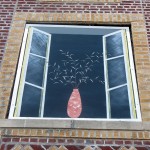Yeshiva Across from Mosque on Church
On a recent visit to Israel I found myself taking in the iconic Western Wall and the ritual dance performed by the orthodox men on the evening of the Sabbath. As we watched the hundreds of orthodox men singing and dancing joyfully about, there was a momentary hush followed by a quiet but distinct snicker as the call to prayer bellowed from the Al Aqsa Mosque just above the wall. The moment of tension quickly passed. The reflection of the sunset bounced brilliantly off the golden Dome of the Rock ; the call and the singing intermingled. It was a beautiful and poignant moment for us, especially because we don’t live there.
When I returned to Brooklyn my everyday existence seemed richer to me. Though nothing had changed, it all felt different than just a few weeks before. I was still living in Kensington. I was still tired of looking at the boarded up windows of the yeshiva across the street and I was still sick of pleading with the mosque on the corner to lower the volume of their call to prayer. Kensington is arguably one of the most diverse neighborhoods in the world which is what makes it both a fascinating and difficult place to live. Most of the communities have little if any interaction with one another, particularly the religious ones. How could it be possible that I was the first to introduce my Muslim neighbor next door to my Orthodox Jewish neighbor just three doors down when they had both lived on the same block for over 20 years? The tensions between the religious and ethnic groups have caused deep divisions within the community that has ultimately prevented us from having a unified voice to advocate for the many needs of the neighborhood. Our little microcosm so obviously mirrors the world at large, particularly where I had recently travelled.
In 2006, I spearheaded the West Kensington Action Group, an organization to promote neighborhood beautification and address environmental concerns, to encourage community building, and to gain attention from our local politicians. However, our most important accomplishment by far has been establishing a network of trust and reciprocity across racial, ethnic, and religious lines by working together to improve our quality of life and civic pride.
Our latest project, to paint the boarded up windows of the yeshiva so that they could be mistaken for real windows, has brought both beauty and constructive discourse to our own little Gaza Strip (as it is referred to around here). The windows appear to be open with various objects sitting on the sills: an ancient vase with olive branches, a cat contemplating a daisy, a vessel with some lotus flowers. The street looks cheerier and the mosque has miraculously lowered the decibel level a little bit.
Change is slow and patience is a virtue I am lacking. I do, however, believe in the power of art for social change. Given the long and tenuous history of both the Mideast and our little microcosm in Brooklyn, there just might be some hope.
Maggie Tobin
September 28th, 2012







